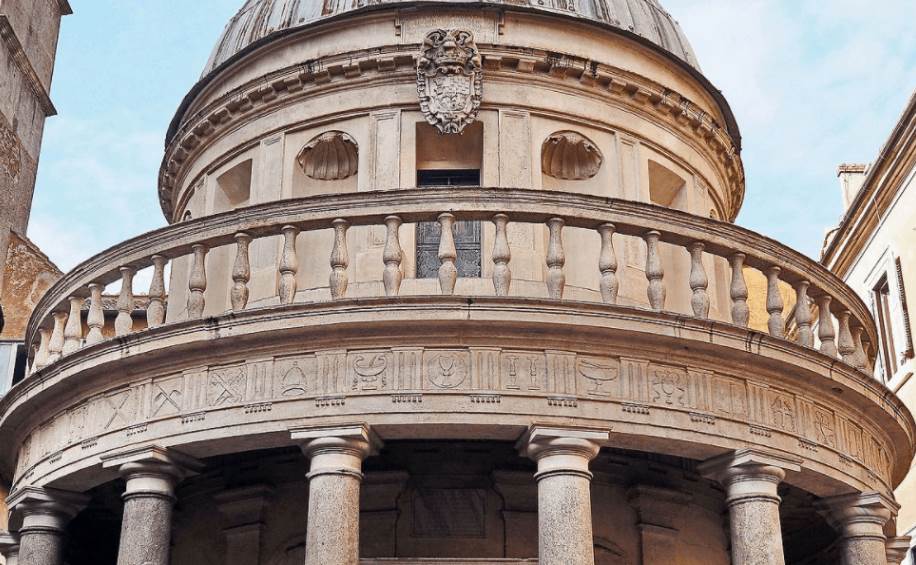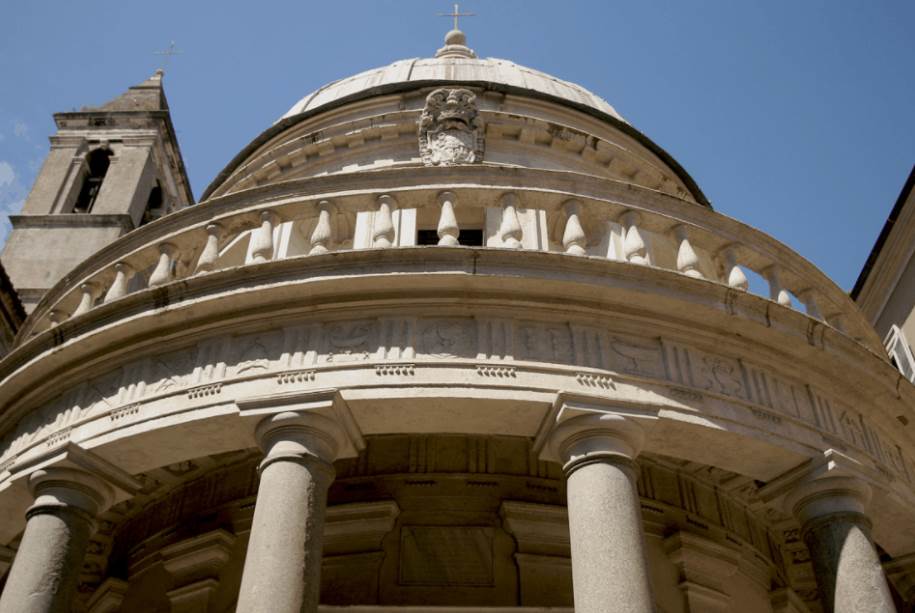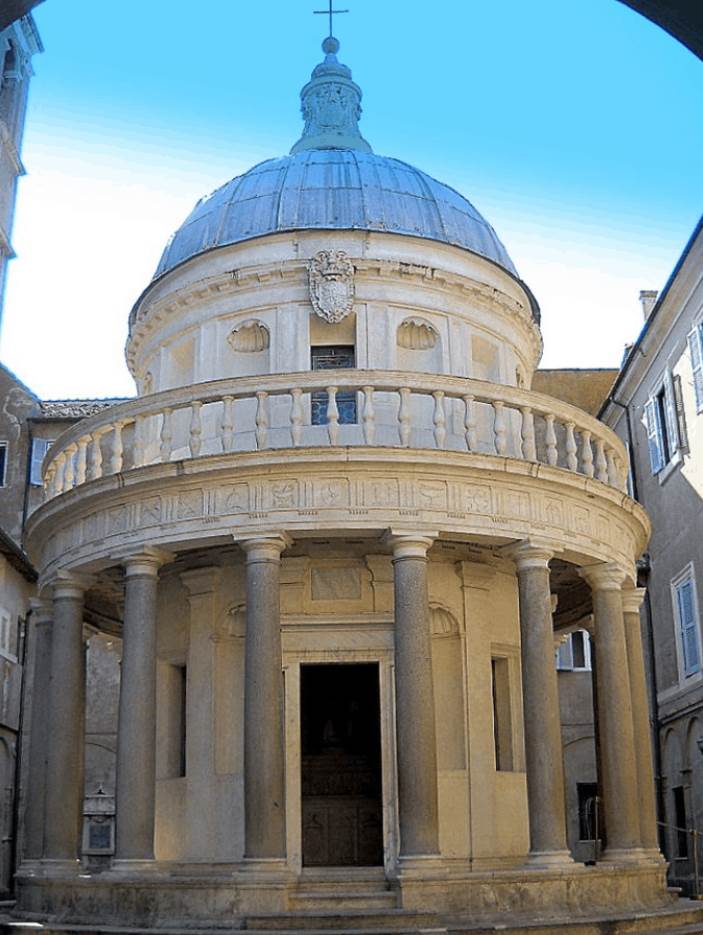This is without a doubt one of the most fascinating and most influential structures of the High Renaissance.
In this post, you’ll discover the ultimate list of interesting facts about The Tempietto, a building that radically changed architecture in the early 16th century.
1. Its name refers to what it really is
The name of this fascinating little building literally translates to “small temple.” And that’s what it really is. The building doesn’t have a particular architectural purpose, can equally be described as a piece of sculpture, and only consists of one space which is topped by a magnificent concrete dome.
The small temple is further adorned with multiple niches and a series of columns that are perfectly aligned to form a harmonious ensemble.

2. It was designed by a famous Italian architect
The building was designed by one of the most influential artists of the Renaissance named Donato Bramante (1444-1514). He single-handedly elevated architecture in this period to another level.
This small temple, among multiple of his famous works, is one of the prime examples of his talent.

3. It was commissioned by King Ferdinand and Queen Isabella of Spain
Bramante was working for the Duke of Milan named Ludovico Sforza in the late 15th century. Sforza also employed one of the most famous artists of all time, the Italian polymath Leonardo da Vinci, at the time.
When Sforza was driven out of Milan, Bramante went straight to Rome, the hotspot of art at the time with other famous artists such as Raphael Umbrias and Michelangelo Buonarroti working on masterpieces such as the School of Athens and the Creation of Adam respectively.
Since he already made his name in Milan, Bramante was hired by Pope Julius II upon arrival and was able to get in contact with people at the highest level, including King Ferdinand and Queen Isabella of Spain, who were the ones who commissioned the Tempietto.

4. It’s unclear when exactly the temple was constructed
The exact date when the small temple was constructed remains unknown, but it’s assumed that work on it started as early as 1502. The building was completed in the year 1512, just 2 years before Bramante passed away.
This also means that Isabella of Spain never saw the completed temple as she passed away in the year 1504, which is supposedly just after construction had started.

5. It’s located inside the courtyard of a church in Rome
One of the things that makes this small temple so remarkable is that it’s located in the courtyard of the San Pietro in Montorio church on the Janiculum hill in Rome. This church was consecrated in the year 1500, which means the temple was built after the church was already completed.
The church has a rich history of housing famous works of art from the Renaissance, including what was considered to be the most famous work of art in the world at the time, the Transfiguration by Raphael, which decorated the church’s high altar until the year 1797.
The church also houses a chapel designed by Gian Lorenzo Bernini and a ceiling fresco by Giorgio Vasari.

6. There’s something else really special about its location
This small temple wasn’t constructed without a solid reason. The original church that was built here dates back to the 9th century and was dedicated to Saint Peter, one of the Apostles of Jesus Christ.
It’s believed that the location where the Tempietto was constructed is the exact location where Saint Peter was crucified, which is believed to have happened around the period that the Great Fire of Rome happened under Emperor Nero in the year 64 A.D.

7. It’s a prime example of the Tuscan order in the Renaissance
The Tuscan Order was one of the two main architectural techniques used by the Ancient Romans and was inspired by the Doric Order, used by the Ancient Greeks.
Bramante’s use of the Tuscan Order was the first of its kind in the Renaissance and inspired numerous architects all across Europe.

8. The Tempietto was inspired by another famous temple
The fact that Bramante integrated the Tuscan Order into this fascinating building is because he was able to study the ancient monuments and buildings located in Rome after he moved there.
Apart from closely studying the Roman Pantheon and its magnificent dome, he also got his inspiration from the Temple of Vesta, a Roman Temple in Tivoli, about 30 kilometers (20 miles) to the northeast of Rome that was built in the 1st century B.C.

9. It was supposed to be expanded but that plan was shelved
Bramante’s plan included multiple additional rings of pillars which would have been perfectly aligned with the pillars supporting the building itself.
This plan was never executed, most probably because Bramante had passed away shortly after the Tempietto was completed.
10. Did it become the inspiration for one of the most famous churches in the world?
One of the most famous religious buildings in the world, Saint Peter’s Basilica, is also located in Rome and was initially designed by nobody else than Donato Bramante. He won an architectural competition with his design that would become the largest church in the world.
Granted, the design was seriously altered and eventually completed by Michelangelo multiple decades later, but the numerous other architects that worked on Saint Peter’s built upon the original plan by Bramante.
Many historians agree that the Tempietto was indeed a major influence in Bramante’s plan of the enormous Basilica in Rome and consider it to be the prototype of his most famous achievement.
And more than that as it has been replicated countless times all across the world and is considered to be one of the most harmonious buildings of the renaissance!



